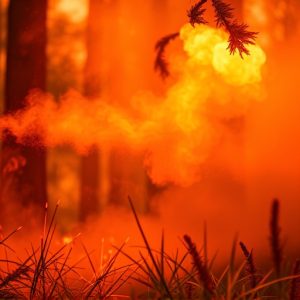Harnessing Wildfire Pepper Spray: A Surveillance and Suppression Strategy
Wildfire pepper spray is a novel, non-toxic tool for fire suppression that law enforcement and fire…….
Wildfire pepper spray is a novel, non-toxic tool for fire suppression that law enforcement and fire management teams are increasingly utilizing. This highly concentrated oleoresin capsicum spray suppresses flames by coating vegetation, rendering it non-combustible. It is particularly effective in combating wildfires and serves as an environmentally friendly alternative to water or chemical retardants, minimizing ecological disruptions. The spray's effectiveness is dependent on specialized training for personnel to ensure its safe and strategic application. Additionally, the spray acts as a deterrent against arsonists and accidental fire starters by causing a rapid physiological impact that incapacitates and halts fire-related activities, thus safeguarding life, property, and natural habitats. Its biodegradable nature and precise application help maintain the integrity of ecosystems, making wildfire pepper spray an indispensable resource in public safety and fire management strategies. Furthermore, its integration with advanced surveillance techniques enhances law enforcement's ability to monitor, deter, and respond to wildland fires effectively, complementing traditional firefighting methods while ensuring both human and environmental safety.
wildfire pepper spray has emerged as a pivotal asset in the arsenal of law enforcement agencies and surveillance operations during wildland firefighting efforts. This article delves into the multifaceted utility of this tool, elucidating its role in enhancing retardant lines and integrating it within surveillance strategies to bolster the protection of both natural environments and human assets. By understanding the science behind wildfire pepper spray, we can appreciate its effectiveness and the potential it holds for improving fire suppression techniques. As we explore its application, it becomes clear that this tool is not just a defensive measure but also a strategic component in the broader context of wildland fire management.
Understanding Wildfire Pepper Spray: A Critical Tool for Law Enforcement in Wildfire Suppression
Wildfire pepper spray represents a critical innovation in the arsenal of tools available to law enforcement agencies for combating wildfires. Unlike traditional methods, this specialized form of pepper spray is designed with a high concentration of oleoresin capsicum, which is capable of quickly and effectively subduing flames upon application. Its efficacy lies in its ability to penetrate through dense vegetation and coat the combustible material, preventing the spread of fire by rendering the fuel source non-combustible. This not only aids in containing the fire but also provides a strategic advantage when used in conjunction with other fire suppression efforts, allowing for more precise control over the fire’s progression.
The deployment of wildfire pepper spray by law enforcement is a testament to the evolving strategies in wildfire management. It serves as an environmentally friendly alternative to traditional fire retardants, which often contain water or chemical compounds that can have long-term ecological impacts. The use of this tool requires specialized training to ensure its safe and effective application, thereby minimizing the risk of adverse effects on both the environment and public health. As such, it is an invaluable asset for law enforcement agencies, offering a non-toxic means of protecting communities, preserving natural habitats, and mitigating the destruction caused by wildfires.
The Science Behind Wildfire Pepper Spray: How It Works and Its Impact on Vegetation Retardant Lines
Wildfire pepper spray represents a significant tool in the arsenal of law enforcement and fire management teams. This advanced formulation incorporates a high concentration of capsaicin, the active ingredient found in chili peppers, which creates an intense irritant when directed at individuals or wind patterns facilitating wildfire spread. The science behind its effectiveness lies in its ability to rapidly alter the physiological response of those exposed, leading to a disorienting sensation that can deter both arsonists and accidental starters from continuing their actions. When deployed as a retardant line, the spray acts by disrupting the sensory receptors in the eyes and respiratory tract, causing an immediate cessation of any activity related to ignition or spreading of the fire. This application not only aids in the protection of life and property but also conserves valuable time for evacuations and strategic containment efforts.
Additionally, the impact of wildfire pepper spray on vegetation near retardant lines is a critical consideration. Unlike traditional fire retardants that may affect soil chemistry or plant growth, the biodegradable nature of pepper spray ensures minimal long-term ecological disruption. Its targeted application allows for precise control over where and how the retardant impacts the landscape, preserving natural vegetation and maintaining its integrity. This selective approach to fire suppression is particularly beneficial in sensitive ecosystems, where the preservation of plant life is crucial for ecosystem health and biodiversity. Law enforcement teams utilize this tool with precision, ensuring that the vegetation’s role as a natural barrier against wildfire spread is not compromised while effectively combating fire threats.
Integrating Wildfire Pepper Spray into Surveillance Strategies: Enhancing Wildland Firefighting Efforts
Law enforcement agencies are increasingly integrating advanced tools into their surveillance strategies to enhance public safety and support various operations. Among these innovations, Wildfire Pepper Spray has emerged as a versatile solution for wildland firefighting efforts. This sophisticated tool allows for precise application of a high-potency irritant that can deter individuals who may be causing or accelerating wildfires. By incorporating Wildfire Pepper Spray into surveillance strategies, agencies can proactively address the threat of arson or intentional wildland fires before they escalate, minimizing potential damage and protecting critical ecosystems. The non-lethal nature of this pepper spray ensures that it is a humane option for deterring potential offenders while preserving the environment. Furthermore, its effectiveness in deterring human intervention in fire-prone areas complements traditional firefighting measures by providing an additional layer of defense against uncontrolled blazes. This integration not only bolsters surveillance capabilities but also supports the broader objective of safeguarding communities and natural landscapes from the devastating impacts of wildfires.


